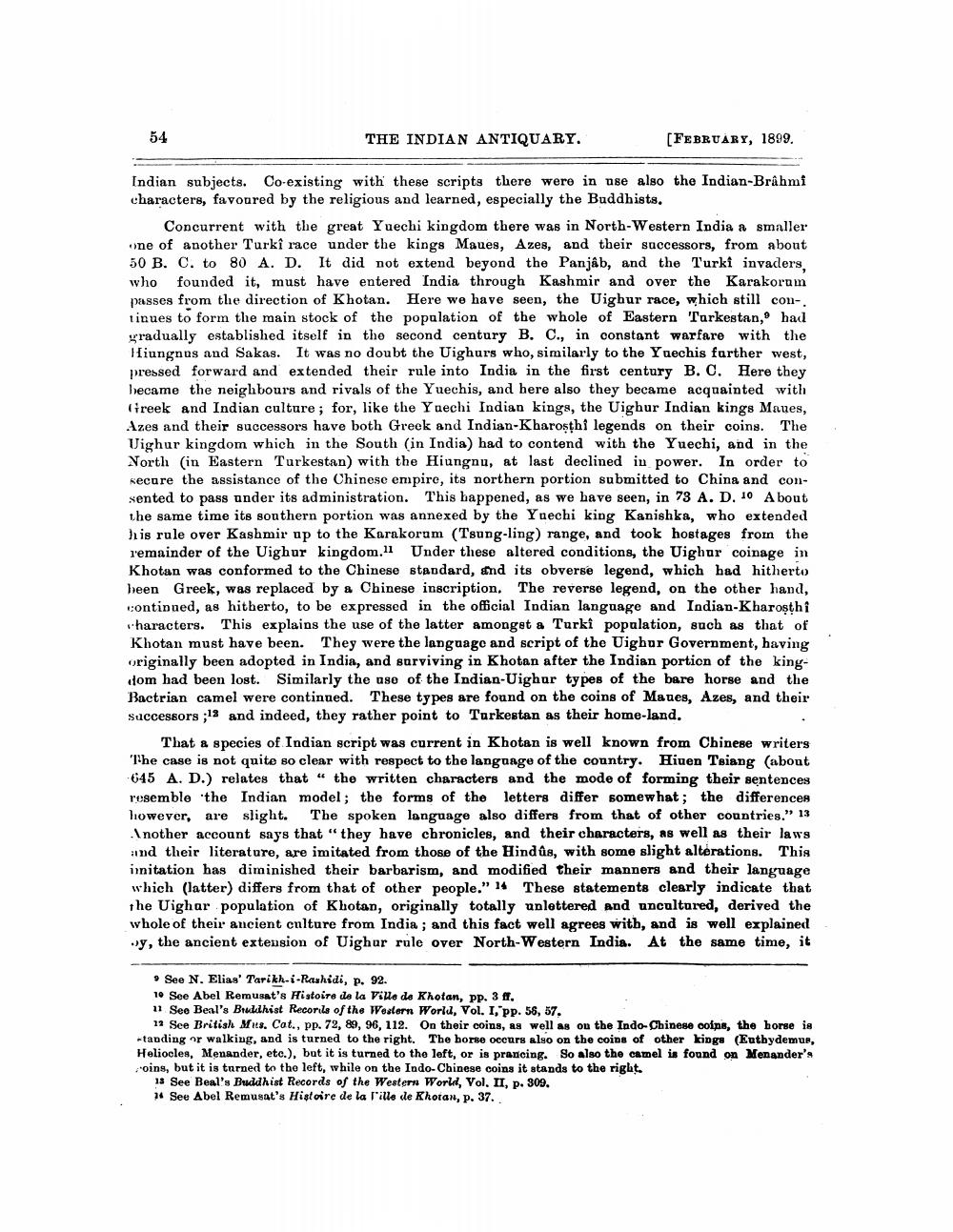________________
THE INDIAN ANTIQUARY.
[FEBRUARY, 1899.
Indian subjects. Co-existing with these scripts there were in use also the Indian-Brahmi characters, favoured by the religious and learned, especially the Buddhists.
Concurrent with the great Yuechi kingdom there was in North-Western India a smaller one of another Turki race under the kings Maues, Azes, and their successors, from about 50 B. C. to 80 A. D. It did not extend beyond the Panjab, and the Turki invaders, who founded it, must have entered India through Kashmir and over the Karakoram passes from the direction of Khotan. Here we have seen, the Uighur race, which still con-. tinues to form the main stock of the popalation of the whole of Eastern Turkestan, bai yradually established itself in the second century B. C., in constant warfare with the Hiungnus and Sakas. It was no doubt the Uighurs who, similarly to the Yuechis further west, pressed forward and extended their rule into India in the first century B. C. Here they became the neighbours and rivals of the Yuechis, and here also they became acquainted with (reek and Indian culture; for, like the Yuechi Indian kings, the Uighur Indian kings Maues, Azes and their successors have both Greek and Indian-Kharosthi legends on their coins. The Uighur kingdom which in the South (in India) had to contend with the Yuechi, and in the North (in Eastern Turkestan) with the Hiungnu, at last declined in power. In order to kecare the assistance of the Chinese empire, its northern portion submitted to China and consented to pass ander its administration. This happened, as we have seen, in 73 A. D. 10 About the same time its southern portion was annexed by the Yuechi king Kanishka, who extended his rule over Kashmir up to the Karakoram (Tsung-ling) range, and took hostages from the remainder of the Uighur kingdom. Under these altered conditions, the Uighur coinage in Khotan was conformed to the Chinese standard, and its obverse legend, which had hitherto been Greek, was replaced by a Chinese inscription. The reverse legend, on the other hand, continued, as hitherto, to be expressed in the official Indian language and Indian-Kharoşthi
haracters. This explains the use of the latter amonget a Turki population, such as that of Khotan must have been. They were the language and script of the Uighur Government, having originally been adopted in India, and surviving in Khotan after the Indian portion of the kingdom had been lost. Similarly the use of the Indian-Uighur types of the bare horse and the Bactrian camel were continued. These types are found on the coins of Maues, Azes, and their Successors;12 and indeed, they rather point to Turkestan as their home-land.
That & species of Indian script was current in Khotan is well known from Chinese writers The case is not qnite so clear with respect to the language of the country. Hiuen Tsiang (about 645 A. D.) relates that “ the written characters and the mode of forming their sentences resemble the Indian model; the forms of the letters differ somewhat; the differences However, are slight. The spoken language also differs from that of other countries." 13
Inother account says that "they have chronicles, and their characters, as well as their laws ind their literature, are imitated from those of the Hindûs, with some slight altérations. This imitation has diminished their barbarism, and modified their manners and their language which (latter) differs from that of other people." 14 These statements clearly indicate that the Uighur population of Khotan, originally totally unlettered and uncultured, derived the whole of their ancient culture from India ; and this fact well agrees with, and is well explained wy, the ancient extension of Uighur role over North-Western India. At the same time, it
See N. Elias' Tarikh-i-Rashidi, p. 92. 10 See Abel Remusat's Histoire de la Ville de Khotan, pp. 3 ff. 11 See Beal's Bullhist Recorils of the Western World, Vol. I, pp. 56, 57.
12 See British Mus. Cat., pp. 72, 89, 96, 112. On their coins, as well as on the Indo-Chinese coins, the horse is *tanding or walking, and is turned to the right. The horse occurs also on the coins of other kings (Euthydemus, Heliocles, Menander, etc.), but it is turned to the left, or is prancing. So also the camel is found on Menander's oins, but it is turned to the left, while on the Indo-Chinese coins it stands to the riglat.
18 See Beal's Buddhist Records of the Western World, Vol. II, p. 309. 14 See Abel Remusat's Histoire de la fillo de Khoran, p. 37.




